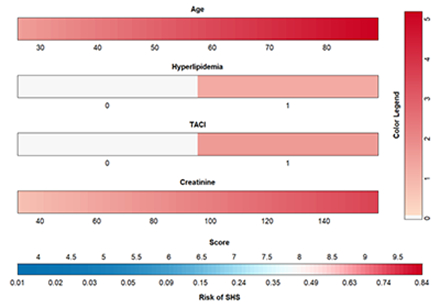Final ID: TP265
Early risk prediction model for stroke–heart syndrome following endovascular therapy
Abstract Body: Objective: Stroke–heart syndrome (SHS) leads to poorer prognosis in patients with acute ischemic stroke (AIS), which makes early identification and prevention of SHS crucial. Therefore, the primary objective of this study was to establish a nomogram-based risk prediction model for SHS following endovascular therapy (EVT) in anterior circulation stroke.
Methods: This retrospective observational study recruited consecutive AIS patients undergoing EVT between January 2014 and June 2021. Utilizing the least absolute shrinkage and selection operator (LASSO) regression and multivariate logistic regression analysis, we screened for variables that demonstrated strong associations with SHS. Significant variables were included to construct risk prediction model and visualized with nomogram. Multiple methods were employed to comprehensively assess the accuracy and calibration of the prediction model. The modified Rankin Scale (mRS) score was utilized to assess the prognosis of patients at 3 months.
Results: A sample of 218 patients was incorporated into the study. The incidence of SHS within two weeks after EVT is 13.8%. After multiple analyses, age (OR 1.060, 95% CI 1.021–1.100, P = 0.002), hyperlipidemia (OR 3.400, 95% CI 1.289–8.968, P = 0.013), creatinine (OR 1.023, 95% CI 1.000–1.046, P = 0.049), and total anterior circulation infarct (TACI, OR 4.875, 95% CI 1.984–11.980, P = 0.001) were included in the risk prediction model. The model has good discriminatory capacity (AUC = 0.812), calibration (Hosmer-Lemeshow test P = 0.855, Brier score = 0.098), and robustness (internal cross-validation AUC = 0.811). SHS independently increased the risk of 3-month unfavorable prognosis (OR 3.267, 95% CI 1.159–9.212, P = 0.025) and mortality (OR 3.484, 95% CI 1.154–10.516, P = 0.027).
Conclusions: SHS significantly increases unfavorable prognosis risk and mortality in AIS patients with EVT. The prediction model based on age, hyperlipidemia, TACI, and creatinine exert good predictive efficacy for early SHS.
Methods: This retrospective observational study recruited consecutive AIS patients undergoing EVT between January 2014 and June 2021. Utilizing the least absolute shrinkage and selection operator (LASSO) regression and multivariate logistic regression analysis, we screened for variables that demonstrated strong associations with SHS. Significant variables were included to construct risk prediction model and visualized with nomogram. Multiple methods were employed to comprehensively assess the accuracy and calibration of the prediction model. The modified Rankin Scale (mRS) score was utilized to assess the prognosis of patients at 3 months.
Results: A sample of 218 patients was incorporated into the study. The incidence of SHS within two weeks after EVT is 13.8%. After multiple analyses, age (OR 1.060, 95% CI 1.021–1.100, P = 0.002), hyperlipidemia (OR 3.400, 95% CI 1.289–8.968, P = 0.013), creatinine (OR 1.023, 95% CI 1.000–1.046, P = 0.049), and total anterior circulation infarct (TACI, OR 4.875, 95% CI 1.984–11.980, P = 0.001) were included in the risk prediction model. The model has good discriminatory capacity (AUC = 0.812), calibration (Hosmer-Lemeshow test P = 0.855, Brier score = 0.098), and robustness (internal cross-validation AUC = 0.811). SHS independently increased the risk of 3-month unfavorable prognosis (OR 3.267, 95% CI 1.159–9.212, P = 0.025) and mortality (OR 3.484, 95% CI 1.154–10.516, P = 0.027).
Conclusions: SHS significantly increases unfavorable prognosis risk and mortality in AIS patients with EVT. The prediction model based on age, hyperlipidemia, TACI, and creatinine exert good predictive efficacy for early SHS.
More abstracts on this topic:
A Novel Machine Learning-based Adverse Cardiovascular Events Risk Algorithm For Cancer Patients Treated With Tyrosine Kinase Inhibitors
Wahi Shawn, Cross James, Mora Ruben, Im Yunju, Kwan Jennifer
3-HKA Promotes the Vascular Remodeling after Stroke by Modulating the Activation of A1/A2 Reactive AstrocytesChen Jun-min, Shi Guang, Yu Lulu, Shan Wei, Zhang Xiangjian, Wang Qun
Readers' Comments
We encourage you to enter the discussion by posting your comments and questions below.
Presenters will be notified of your post so that they can respond as appropriate.
This discussion platform is provided to foster engagement, and simulate conversation and knowledge sharing.
You have to be authorized to post a comment. Please, Login or Signup.
Rate this abstract
(Maximum characters: 500)

